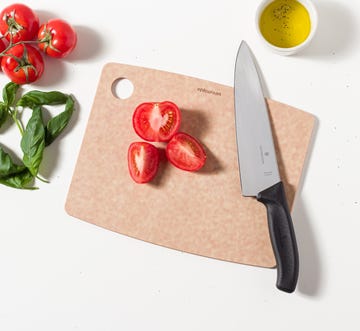There’s absolutely no denying that we’re cheese obsessives here at Delish—we have thousands of melty, gooey cheese-focused recipes to prove it. While we love ALL cheese, in this grand world of dairy products, there is no question that Italy produces some of the best there is. Centuries of cheesemaking expertise and traditions passed down through generations have earned Italy its place as one of the greatest cheesemaking countries in the world. What would a cheese plate, tiramisu, or bowl of pasta look like without Fontina, Mascarpone, or Pecorino? To brush up on these versatile and delicious cheeses, check out the cheatsheet below—with research provided by the Italian Trade Commission—and discover new ways to work cheesy goodness into your diet.
Pecorino Toscano
The Rundown
Pecorino cheeses are produced all over Italy. The word pecorino comes from the Italian word pecora, which means sheep: this cheese is made from lucky flocks. Fun fact: Pecorino used to be called March cheese because of its production in the month of March.
Pecorino Toscano is softer and milder than its well-known cousin, Pecorino Romano, and is available three ways: fresco, semi-stagionato, and stagionato, depending on how long the cheese has been aged. Fresco, aka young Pecorino, is semi-soft and moist with a pale yellow color. It has a delicate grassy flavor—it’s said that you can smell the pastures of Tuscany with every bite. As Pecorino ages, it becomes increasingly firmer and nuttier. Because of the high amount of butterfat, ripened Pecorino is a little oily, in the best possible way. When the cheese is served at room temperature, you’re likely to see little beads of oil on top, known as “butterfat tears.” Don’t worry! This means the cheese is primed and ready for eating.
Snacking and Cooking Tips
Young, fresh Pecorino is delightful sliced and eaten alongside fresh fruit or layered into a sandwich. It’s also perfect melted into almost any dish (think pasta and polenta), and makes an excellent grilled-cheese sandwich. Aged Pecorino is excellent cut into wedges and drizzled with honey, or served alongside juicy ripe pears and walnuts. Keep some on hand to grate into pastas, salads, and soups too.
Mascarpone
The Rundown
Luscious Mascarpone is a rich, fresh, creamy cheese made from pasteurized cow’s milk in Lombardy. It’s said that cattle breeders needed to utilize the milk produced by cows about to give birth, which was exceptionally rich, and thus mascarpone was born. This spreadable cheese is high in butterfat and supremely silky, with a delicate flavor.
There are plenty of theories as to the origins of its name, but it most likely is derived from mascarpia (or mascherpa), which means ricotta: The two cheeses are made by similar methods.
Snacking and Cooking Tips
Mascarpone can be used in sweet and savory recipes, but it’s probably most famous for its key role in classic Italian tiramisu. Serve it with fresh fruit, drizzled with honey, or alongside tarts and pies (much like whipped cream). On the savory side, Mascarpone can be made into all sorts of dips with a variety of spices and herbs, or pureed into soups and sauces. It can also be used to enrich pastas, risotto, polenta, and mashed potatoes. Try a schmear on toasted bread, too!
Provolone Dolce and Piccante
The Rundown
Italy’s Provolone is a complex cheese, not to be confused with American-made provolone. This cow’s milk cheese is produced primarily in Lombardy and Veneto, and some of the most prized provolone comes from the milk of cows grazing along the banks of the Po River. Provolone is in the category of stretched and pulled cheeses (like mozzarella) known as pasta filata, which means spun paste. Provolone dolce (mild) is aged for less than three months, with a smooth, buttery, delicate flavor and texture. Provolone piccante (sharp) is aged from four months to three years, developing a deliciously sharp flavor and firm, almost granular texture.
Snacking and Cooking Tips
Provolone dolce melts wonderfully for sandwiches, burgers, and pizza, and can also be grated into dishes for a mild and creamy effect. You can slice Provolone piccante and enjoy it alongside ripe fruit, olives, roasted peppers, and bread. It can be grated into pasta and salads and sprinkled over vegetables and eggs.
Grana Padano
The Rundown
Cistercian monks in Northern Italy’s Po River Valley first created Grana Padano in the 12th century, where it has been produced in almost the exact same way ever since. Grana Padano starts with cow’s milk from two milkings (one in the morning and one in the evening) which is then partially skimmed, cooked twice in copper cauldrons, brined, and left to age between 9 and 30 months. Once the cheese passes strict quality control tests, it gets stamped and branded as authentic Grana Padano. Grana Padano is firm, nutty, and a little sweet, with delicious flaky crystals. It’s often compared to Parmigiano-Reggiano, but it’s a bit milder, and easier on your bank account, too!
Snacking and Cooking Tips
Grate Grana Padano into pasta, risotto, or salads, or use it in pesto. If you’re feeling really fancy, break it into small chunks and drizzle with honey or truffle oil, or throw it on a cheese board, ideally positioned alongside dates or ripe figs. Pro tip: Don’t throw away those rinds! They are fantastic simmered into soups, stews and beans.
Fontina Valle D'Aosta
The Rundown
Fontina Valle D’Aosta has been made in the mountainous Western Alps near the Italian-Swiss border since the 12th century. This semi-soft, washed-rind cheese is made from the unpasteurized milk of cows grazing on Alpine pastures at elevations of more than 6500 feet. It is typically aged for a minimum of 80 days. Fontina boasts a rich, nutty, buttery flavor with a deliciously creamy, soft texture, though more mature Fontina will be darker and drier, with a nutty, fruity flavor. Authentic Fontina is only made in the Valle D’Aosta and is stenciled with a large circle around a mountain, with the word “Fontina” stamped on it.
Snacking and Cooking Tips
Thin slabs of this distinct cheese deserve a spot on any cheese board, but Fontina is also a melting dream come true. It’s one of the main components of fonduta (Italian-style fondue), and stellar for melting into pasta (mac and cheese, anyone?), polenta, risotto and for using in gratins. For all the grilled-cheese lovers out there: It’s also ideal for melting onto sandwiches.


















